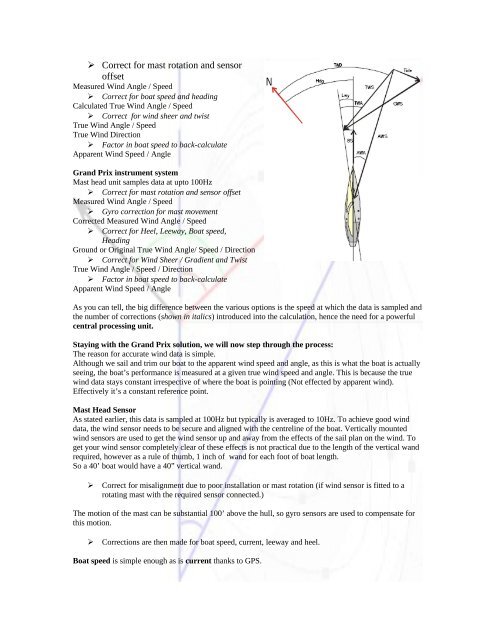Race boat instruments â understanding it all - L-36 Fleet
Race boat instruments â understanding it all - L-36 Fleet
Race boat instruments â understanding it all - L-36 Fleet
You also want an ePaper? Increase the reach of your titles
YUMPU automatically turns print PDFs into web optimized ePapers that Google loves.
Correct for mast rotation and sensoroffsetMeasured Wind Angle / Speed Correct for <strong>boat</strong> speed and headingCalculated True Wind Angle / Speed Correct for wind sheer and twistTrue Wind Angle / SpeedTrue Wind Direction Factor in <strong>boat</strong> speed to back-calculateApparent Wind Speed / AngleGrand Prix instrument systemMast head un<strong>it</strong> samples data at upto 100Hz Correct for mast rotation and sensor offsetMeasured Wind Angle / Speed Gyro correction for mast movementCorrected Measured Wind Angle / Speed Correct for Heel, Leeway, Boat speed,HeadingGround or Original True Wind Angle/ Speed / Direction Correct for Wind Sheer / Gradient and TwistTrue Wind Angle / Speed / Direction Factor in <strong>boat</strong> speed to back-calculateApparent Wind Speed / AngleAs you can tell, the big difference between the various options is the speed at which the data is sampled andthe number of corrections (shown in <strong>it</strong>alics) introduced into the calculation, hence the need for a powerfulcentral processing un<strong>it</strong>.Staying w<strong>it</strong>h the Grand Prix solution, we will now step through the process:The reason for accurate wind data is simple.Although we sail and trim our <strong>boat</strong> to the apparent wind speed and angle, as this is what the <strong>boat</strong> is actu<strong>all</strong>yseeing, the <strong>boat</strong>’s performance is measured at a given true wind speed and angle. This is because the truewind data stays constant irrespective of where the <strong>boat</strong> is pointing (Not effected by apparent wind).Effectively <strong>it</strong>’s a constant reference point.Mast Head SensorAs stated earlier, this data is sampled at 100Hz but typic<strong>all</strong>y is averaged to 10Hz. To achieve good winddata, the wind sensor needs to be secure and aligned w<strong>it</strong>h the centreline of the <strong>boat</strong>. Vertic<strong>all</strong>y mountedwind sensors are used to get the wind sensor up and away from the effects of the sail plan on the wind. Toget your wind sensor completely clear of these effects is not practical due to the length of the vertical wandrequired, however as a rule of thumb, 1 inch of wand for each foot of <strong>boat</strong> length.So a 40’ <strong>boat</strong> would have a 40” vertical wand.Correct for misalignment due to poor inst<strong>all</strong>ation or mast rotation (if wind sensor is f<strong>it</strong>ted to arotating mast w<strong>it</strong>h the required sensor connected.)The motion of the mast can be substantial 100’ above the hull, so gyro sensors are used to compensate forthis motion.Corrections are then made for <strong>boat</strong> speed, current, leeway and heel.Boat speed is simple enough as is current thanks to GPS.
















